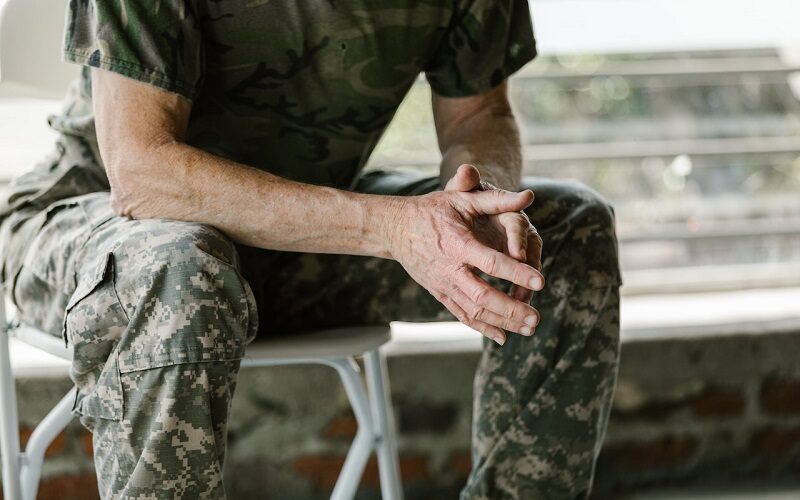During military service, service members are often exposed to violence, threats to personal safety, and other traumatic events. These experiences can significantly impact the mental health of active duty service members and veterans. According to the National Alliance for Mental Health, approximately 1 in 4 active duty service members show symptoms of a mental health condition.
This makes it even more important to understand the benefits of therapy for veterans and the mental health concerns that service members may be facing. Increased awareness of veterans and mental health care can make it easier for people to access the care they need.
How Does Military Service Affect Mental Health?
When people serve in the military, they’re separated from family members, friends, and other forms of social support, often for extended periods. Military service also requires people to work in stressful or traumatic environments, facing combat stress and other factors. As a result, service members face many risks, including the risk of physical harm.
In addition to the challenges faced during service, post-traumatic stress disorder can make it difficult for veterans to transition to civilian life. Relationship struggles, social exclusion, personality disorder, and homelessness are all problems encountered by veterans, and these issues severely impact mental health.
What percentage of veterans suffer from mental health conditions?
Military service is a sacrifice that puts many people at increased risk for a variety of physical and mental health conditions. One study found that nearly 25% of non-deployed, active-duty military members show symptoms consistent with a serious mental health condition. Within that group, 11% had symptoms of multiple conditions.
Common Mental Health Conditions in Veterans
Military service can take a toll on health and well-being, which is why military mental health concerns are so prevalent and must be better addressed.
“Rates of depression, suicide, and addiction continue to be of increased concern for military veterans. Often, these diagnoses were triggered by service-connected trauma. If you are a veteran and are having thoughts of suicide, please reach out to the Crisis Line by calling or texting 9-8-8 and selecting Option 1 for military members and veterans.”
– Talkspace therapist Ashley Ertel, LCSW, BCD, C-DBT
While several conditions affect veterans, research shows that the following are particularly common.
PTSD
Post-traumatic stress disorder (PTSD) rates are significantly higher in veterans than in the general populace. While approximately 6.8% of adults are diagnosed with PTSD, reports show that about 12.9% of veterans receive a PTSD diagnosis. In a study from 2014, 87% of veterans reported exposure to at least one traumatic event. If you know a veteran struggling with PTSD, or helping veterans is something you’re passionate about, learn how to help veterans with PTSD.
Depression & suicide
Approximately 23% of active service members and veterans have depression, making it the most common mental health condition among military members. Tragically, suicide rates are high among veterans with depression (particularly depression in men) and other mental health symptoms. According to the U.S. Department of Veteran Affairs, the suicide rate for veterans is 57% higher than for civilians.
Addiction
Many veterans struggle with addiction, and more than 1 in 10 have a substance use disorder. 65% of veterans seeking addiction treatment report alcohol as the primary substance they abuse. Some veterans have injuries that leave them with severe pain, increasing their risk of opioid addiction.
Psychiatric disorders post-traumatic brain injury
From 2000 to 2017, the Department of Defense reported over 375,000 traumatic brain injuries (TBIs) among members of the armed forces. These injuries can lead to many complications, including mental health issues. The National Health Institute reports that up to 1 in 5 people experience mental health symptoms after a TBI.
The Stigma Around Mental Health in the Military
Although military mental health issues are common, many people never seek treatment. One study found that more than 60% of military members don’t get help for mental health concerns. The stigma surrounding mental health issues can keep service members from getting the care that they need.
Many active-duty service members fear that mental health treatment could harm their careers. In addition, military members may feel that asking for help is a sign of weakness. Unfortunately, veterans face similar stigmas, and studies indicate that most veterans who struggle with mental health never seek treatment. According to research conducted by the Wounded Warrior Project, 34.8% of veterans struggle accessing mental health care within the VA system, despite approximately 75% of veterans suffering from PTSD.
Mental Health Resources for Veterans
Although there are many issues surrounding veterans and mental health, resources are available to veterans who are ready to seek treatment. These resources include:
The Veterans Crisis Line
The Veterans Crisis Line is an emergency hotline that provides veterans with 24/7 support. They can call, text, or chat online to connect with a qualified care provider. Responders can connect veterans with local resources and support.
“Military members and veterans are at risk of developing mental health conditions just like their civilian counterparts; however, the stigma for seeking help within this population continues to remain higher than in the civilian population. Seeking help is a sign of strength, and I encourage all military members, veterans, and their families to utilize the many available resources — most at no cost to the member–when in need.”
– Talkspace therapist Ashley Ertel, LCSW, BCD, C-DBT
Vet Centers
Vet Centers are counseling centers located across the United States. These centers offer professional counseling and other services designed to help veterans transition to civilian life. Many staff members at Vet Centers are also veterans and can provide guidance and support.
Solid Start
The VA’s Solid Start program works to support military personnel as they transition to civilian life. Solid Start representatives help veterans manage stress and connect them with resources to help them during this adjustment period.
The National Center for Post-Traumatic Stress Disorder
The National Center for Post-Traumatic Stress Disorder is a research and educational center focused on traumatic stress and PTSD. While the center strives to help all people with PTSD, there is a focus on the needs of veterans. The center seeks to help people understand PTSD better and get the help they need.
The Veteran Affairs Polytrauma System of Care
The Veterans Affairs Polytrauma System of Care is a network of rehabilitation programs that help veterans suffering from traumatic brain injuries and polytrauma. These programs offer various services, including case management, care plans, rehabilitation treatments, and psychosocial support.
Addressing Mental Health with Therapy for Veterans
The risk of mental health issues and PTSD in veterans is significant. On average, there are 17 veteran suicides each day, which is why it’s critical for veterans to seek treatment. No matter what kind of military mental health concerns you’re struggling with, therapy can help. Talkspace provides online therapy for veterans and can help you get the support you need. We partner with major healthcare plans across the country like Cigna, Optum, Aetna, Medicare, TRICARE, and more.
Sources:
- Veterans & Active Duty. NAMI. https://www.nami.org/Your-Journey/Veterans-Active-Duty Accessed October 23, 2022.
- Kessler RC, Heeringa SG, Stein MB, et al. Thirty-day prevalence ofDSM-ivmental disorders among nondeployed soldiers in the US army. JAMA Psychiatry. 2014;71(5):504. doi:10.1001/jamapsychiatry.2014.28. https://jamanetwork.com/journals/jamapsychiatry/fullarticle/1835338. Accessed October 23, 2022.
- Kessler RC, Chiu WT, Demler O, Walters EE. Prevalence, severity, and comorbidity of 12-month DSM-IV disorders in the national comorbidity survey replication. Archives of General Psychiatry. 2005;62(6):617. doi:10.1001/archpsyc.62.6.617. https://jamanetwork.com/journals/jamapsychiatry/fullarticle/208671. Accessed October 23, 2022.
- Wisco BE, Marx BP, Wolf EJ, Miller MW, Southwick SM, Pietrzak RH. Posttraumatic stress disorder in the US veteran population. The Journal of Clinical Psychiatry. 2014;75(12):1338-1346. doi:10.4088/jcp.14m09328. https://pubmed.ncbi.nlm.nih.gov/25551234/. Accessed October 23, 2022.
- Moradi Y, Dowran B, Sepandi M. The global prevalence of depression, suicide ideation, and attempts in the military forces: A systematic review and meta-analysis of Cross Sectional Studies. BMC Psychiatry. 2021;21(1). doi:10.1186/s12888-021-03526-2. https://bmcpsychiatry.biomedcentral.com/articles/10.1186/s12888-021-03526-2. Accessed October 23, 2022.
- 1. Fales A, Choi J, Borger C, et al. 2016 Wounded Warrior Project ® Survey Report of Findings.; 2016. https://www.woundedwarriorproject.org/media/qibpphny/2016-wwp-annual-warrior-survey.pdf
- Veteran Suicide Data and Reporting. Va.gov: Veterans Affairs . https://www.mentalhealth.va.gov/suicide_prevention/data.asp. Published September 14, 2018. Accessed October 23, 2022.
- Miller L. Statistics on veterans and substance abuse. veteranaddiction.org. https://veteranaddiction.org/rehab-guide/veteran-statistics/. Published August 19, 2021. Accessed October 23, 2022.
- Lin L(A, Peltzman T, McCarthy JF, Oliva EM, Trafton JA, Bohnert ASB. Changing trends in opioid overdose deaths and prescription opioid receipt among veterans. American Journal of Preventive Medicine. 2019;57(1):106-110. doi:10.1016/j.amepre.2019.01.016. https://www.ajpmonline.org/article/S0749-3797(19)30076-5/fulltext. Accessed October 23, 2022.
- Mental Health – Effects of TBI. Va.gov: Veterans Affairs. https://www.mentalhealth.va.gov/tbi/index.asp. Accessed October 23, 2022.
- Stein MB, Jain S, Giacino JT, et al. Risk of posttraumatic stress disorder and major depression in civilian patients after mild traumatic brain injury. JAMA Psychiatry. 2019;76(3):249. doi:10.1001/jamapsychiatry.2018.4288. https://jamanetwork.com/journals/jamapsychiatry/fullarticle/2722564. Accessed October 23, 2022.
- Sharp M-L, Fear NT, Rona RJ, et al. Stigma as a barrier to seeking health care among military personnel with mental health problems. Epidemiologic Reviews. 2015;37(1):144-162. doi:10.1093/epirev/mxu012. https://academic.oup.com/epirev/article/37/1/144/423274
- Kline AC, Panza KE, Nichter B, et al. Mental health care use among U.S. military veterans: Results from the 2019–2020 national health and resilience in veterans study. Psychiatric Services. 2022;73(6):628-635. doi:10.1176/appi.ps.202100112. https://ps.psychiatryonline.org/doi/10.1176/appi.ps.202100112. Accessed October 23, 2022.
- Veterans Crisis Line. https://www.veteranscrisisline.net/. Accessed October 23, 2022.
- Program VC. Va.gov: Veterans Affairs. U.S. Dept of Veteran Affairs. https://www.vetcenter.va.gov/. Published August 15, 2013. Accessed October 23, 2022.
- U.S. Department of Veterans Affairs VBA. Va.gov: Veterans Affairs. VA Solid Start. https://www.benefits.va.gov/TRANSITION/solid-start.asp. Accessed October 23, 2022.
- Polytrauma/TBI System of Care. Va.gov: Veterans Affairs. https://www.polytrauma.va.gov/index.asp. Published August 15, 2013. Accessed October 23, 2022.
- Reducing military and veteran suicide. Centers for Disease Control and Prevention. https://www.cdc.gov/washington/testimony/2022/t20220615.htm. Published June 24, 2022. Accessed October 28, 2022.
Talkspace articles are written by experienced mental health-wellness contributors; they are grounded in scientific research and evidence-based practices. Articles are extensively reviewed by our team of clinical experts (therapists and psychiatrists of various specialties) to ensure content is accurate and on par with current industry standards.
Our goal at Talkspace is to provide the most up-to-date, valuable, and objective information on mental health-related topics in order to help readers make informed decisions.
Articles contain trusted third-party sources that are either directly linked to in the text or listed at the bottom to take readers directly to the source.





